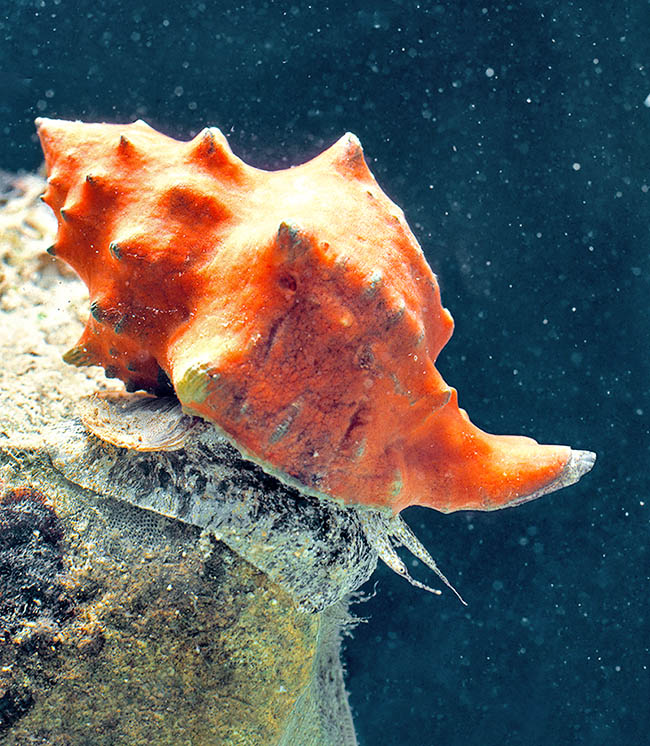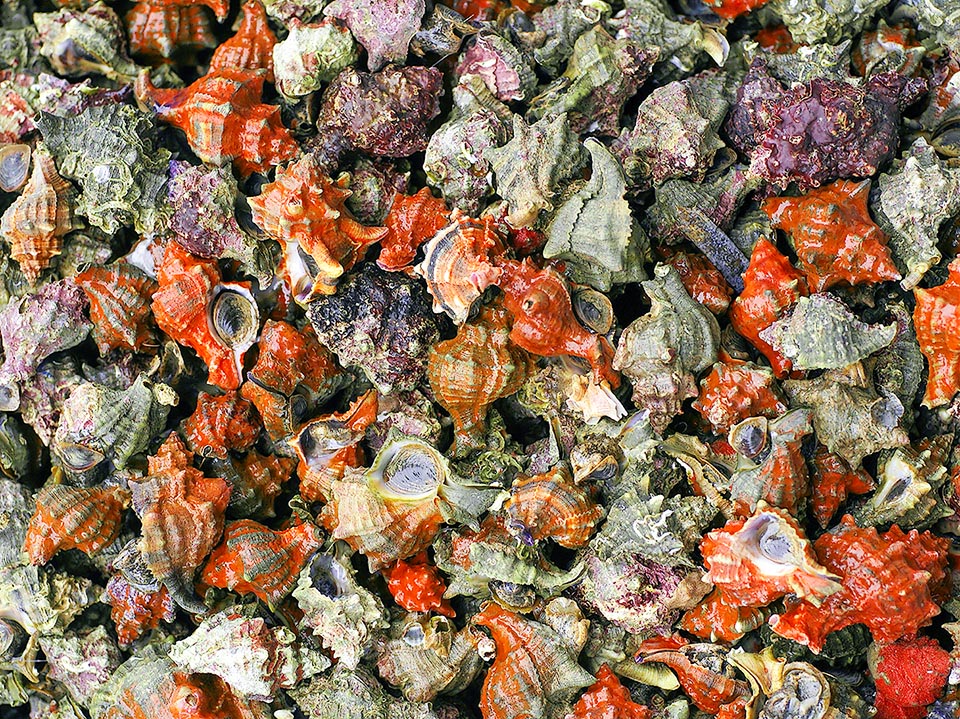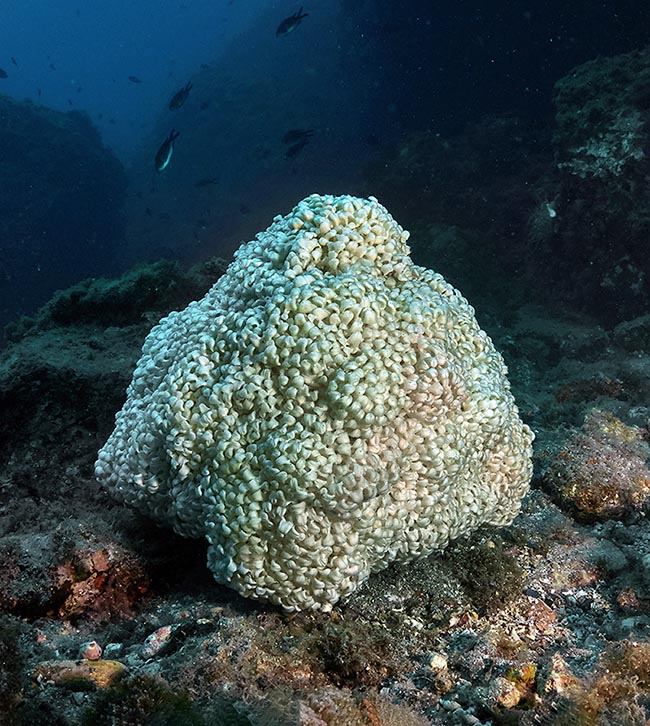Family : Muricidae

Text © Dr Domenico Pacifici

English translation by Mario Beltramini

Hexaplex trunculus is common in Mediterranean and the near Atlantic coasts up to Canary Islands and Açores © Giuseppe Mazza
Hexaplex trunculus (Linnaeus, 1758) known also with the name of Murex trunculus is a marine gastropod belonging to the family Muricidae and gone down in history together with its sister species Bolinus brandaris for the production, yore, of the famous purple.
The old method needed about 12.000 specimens to obtain one single gram of dye, making the price of the product very high and accessible only to the wealthiest class of aristocracy.
The name of the genus Hexaplex comes from the Latin “hexa”, six, and “plectere”, to intertwine, to twist, with reference to the structure of the shell which was counted as having six whorls whilst nowadays the new method of counting has brought them to seven, keeping, however, the nomenclature unchanged.
The name of the species trunculus also comes from the Latin “trunculus”, truncated, incomplete, but there are several theories about the origin of such a name. Starting from Latinized Indo-European languages, it might come from “trux”, ferocious, wild, with the diminutive suffix “ulus”.
Zoogeography
Hexaplex trunculus is a species common all over the Mediterranean Sea that has spread to many areas of the Atlantic Ocean through Gibraltar Strait also due to human accidental intrusion. Particularly, in the Atlantic portion, can be found in the beaches of Spain, Canary Islands and Portugal, in the Açores and in Morocco.
Ecology-Habitat
Hexaplex trunculus prefers the shallow waters, with a substratum that may vary from rocky to sandy.
Particular characteristic of this mollusk is its unbelievable voracity. It is an opportunistic predator species of other mollusks known for attacking in groups and not showing any preference for the size of the prey, regardless of its level of hunger. Various studies have underlined that there is a feeding strategy during the predation, based on the size of the prey.

Used together with Bolinus brandaris in old times to produce the purple, it is nowadays fished like this one for food purposes © Hans Hillewaert
In the small preys the shell was holed whilst with bigger ones the shell did show marginal chippings, due to the opening of the shell. One of the choice prey of Hexaplex trunculus is the bivalve Mytilus galloprovincialis.
Morphophysiology
Thanks to its marked polymorphism, as happens also for the similar species Bolinus brandaris with which it is often mistaken, it is difficult to identify a unique conformation of the shell, as this may have many shapes. Usually the shell presents stocky, large and robust, of brown colour with purple or brown spiral bands and with a length that may vary from 4 to 9 cm.

The eggs are spawned inside whitish capsules that, united, form large bunches and clusters stuck to the rocky substratum. The larvae metamorphose inside these structures and get out as young mollusks © Ana Carrapiso
Very often the colour of the shell may be masked by weeds and sponges covering it or by purple excretions produced by the mollusk itself.
It has seven whorls and these can have various outgrowths varying as shape or size depending on the geographical area: for instance, in the Mediterranean is present the variant with less marked outgrowths.
Moreover, the operculum from which gets out the animal is incredibly big with an outer lip wide and coriaceous. And also the mollusk can have different colours passing from brown to dark violet.
Ethology-Reproduction
Although Hexaplex trunculus has separate sexes, there are no external physical characteristics that differentiate the male from the female excluding the genital organs. During the reproductive period, mainly in May and June, it is possible to note various individuals merged in a sort of a ball that can reach considerable dimensions.
The eggs are spawned inside whitish capsules that, united with each other, form large bunches and clusters glued to the rocky substratum. The larvae, once hatched, develop inside these structures before leaving, metamorphosed, the nest in the form of young mollusks.
The large quantity used by man for collecting purpose as well as for food purpose made necessary the application of minimum catching sizes and quite specific fishing periods.
Synonyms
Murex (Muricanthus) trunculus Linnaeus, 1753; Hexaplex (Trunculariopsis) trunculus (Linnaeus, 1758); Murex (Phyllonotus) trunculus Linnaeus, 1758; Murex polygonulus Lamarck, 1822; Murex fasciatus Risso, 1826; Murex ramulosus Risso, 1826; Murex falcatus Sandri & Danilo, 1856; Murex dumosus de Stefani, 1875; Murex soldanii de Stefani, 1875; Murex rivalis Monterosato, 1923; Murex conglobatus var. gallica Dollfus, 1926; Murex (Muricanthus) trunculus var. spinosa Coen, 1933; Murex armigerus Settepassi, 1970.
→ To appreciate the biodiversity within the MOLLUSCS please click here.
